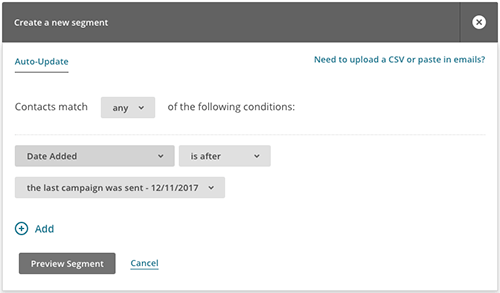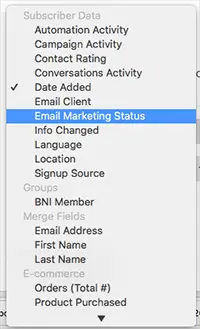How To Create A New Audience Group In Mailchimp
Mailchimp is a hugely popular email marketing platform, and for good reason. It's easy to use, it's free if your list has fewer than 2000 contacts, and packs in a lot of awesome features, even if you're on the free plan.
However, over the 10 years I've been working with my customers to help them use and deploy Mailchimp, I have frequently met people who aren't using it as effectively as they could be. They muddle their way through the process of setting up an email ... and breath a sigh of relief when they press the Send button.
Yet there are many things they could be doing to use Mailchimp more effectively. Here are three things that I frequently come across where Mailchimp users are "doing it wrong".
1. You're using Audiences when you should be using Groups
In Mailchimp, your contacts are stored in something called an Audience (also known as a list). Mailchimp requires you to have at least one audience and, depending on your Mailchimp plan, you can have more than one.
However, the fact that you can have multiple audiences doesn't necessarily mean that you should. If you think that segmenting your subscribers is best done through multiple audiences, then think again!
One good reason to use multiple audiences is where you have two or more completely separate groups of contacts, and you will always send different emails to each audience. But if you have any cross-over at all between your audiences, you should consider merging them into one audience. Otherwise, you risk sending the same email to somebody twice.
A good reason not to use multiple audiences is that Mailchimp counts contacts in each audience separately. So, if you have two audiences of 1500 contacts, but 200 of those contacts are in both audiences, then you're paying for them twice (or, if you're on the free plan, you'll hit the free plan limit earlier than you need to).
Another reason not to use multiple audiences is that it makes segmentation and marketing automation with Mailchimp a lot harder. Imagine you have two audiences - Dog Lovers and Cat Lovers. Some people are in both audiences. Let's say you want to send an email campaign to everyone who is both a Dog Lover and a Cat Lover. You can't! You have to send a separate email to both audiences. If everyone was in the same audience, this would be a piece of cake.
Reason three to use just one audience is that when someone is in two audiences, they have to unsubscribe separately from each audience. You know how annoyed you get when unsubscribe from a company's mailing audience, but the emails keep coming? Don't be that business.
Finally, every business is different. There are some business scenarios where multiple audiences are appropriate. But think carefully before you go that route.
Here are some pro tips for working with Audiences
- If you've got more than one audience and realise you only need one - don't panic! It's possible to merge two audiences together. The process can be a little tricky, especially if you have a lot of contacts in both audiences. You also can't use Mailchimp's Combine Audiences tool to merge an audience for which you have sent a campaign in the last 7 days. Read our detailed lesson on combining audiences here.
- Even if you're OK with having multiple audiences, be aware that Mailchimp treats the contacts in two audiences as two separate people. This can make targeting them tricky, since there may be some information in one audience that doesn't exist in the other. And remember that unsubscribing from one audience doesn't unsubscribe customers from the other audiences in your account.
- I recommend against creating additional "holding pen" audiences into which you import new audiences of contacts (e.g. people who signed up for your prize draw at the local home show) until you establish that they're "good" contacts. It is good practice to treat these new contacts with caution since they may all immediately unsubscribe and then complain they never signed up. This dents your reputation with Mailchimp and could get you banned. However you woudld be better off adding them to your existing audience in a new "Home Show" group, and then send them an email thanking them for their entry. Make sure to apologise if they didn't intend to subscribe, and make sure they know they can unsubscribe immediately using the link in the email. This won't stop them unsubscribing, but hopefully reduces the chance of them complaining.
2. You're not using Groups effectively (or at all)
Groups are used to segment your database. Remember the Dog Lovers and Cat Lovers I mentioned earlier? That scenario would have been much easier with one audience and two groups. Subscribers could have belonged to both groups, which would have made it easy to send an email to someone who loves both dogs and cats.
Groups in Mailchimp allow you "tag" individual contacts in different ways. The idea is that you create one or more Group Categories (e.g. Favourite Food, Type of Car) and then create Group Names within each.
When you send an email campaign, you can define the audience for the campaign by specifying that only members of certain groups should be included.
Groups can be public or hidden. Both types can be included in your signup forms, but contacts will only see the public groups. For example, you might let your contacts choose from an audience of the services they're interested in hearing about, but they won't see the groups that you use to identify whether they have purchased from you recently. Subscribers can also see your public groups when they edit their preferences for your audience.
Mailchimp lets you have 60 Group Names per audience. That might sound like a lot, but what if you wanted to create a group where contacts can specify which country they are from? You'd need over 120 group names to do that. In this case, you can actually add a Country field to your forms, and use that as part of your audience definition. So it's important to think carefully how you will use Groups before they get away on you.
Here are a couple of pro tips for using Groups in Mailchimp
- Make sure you know what the subscriber preferences screen looks like, in case you're giving away more information about your customers than you realise, or have some public groups that should be hidden. This could be embarrassing for you at best, and the source of a customer complaint - or legal action - at worst.
- you can import data about your contacts from a spreadsheet. This is a great way to assign contacts to groups, particularly hidden groups. A good way to do this is to export your audience from Mailchimp to a spreadsheet file, open the audience in Excel and manually tag your contacts into different groups, and then import them back into Mailchimp. Mailchimp can merge the incoming audience with existing contacts and update those records.
3. You're sending the same emails to everyone in your audience
Segments allow you to split your audience up in different ways so you can send emails that are better targeted at their recipients.
If you're not using segments, then you're probably sending the same email to everyone in your audience. This is usually a waste of time! It's unlikely that you can write one email that is interesting to everyone and relevant in your audience.
Whilst it can take more time to write different emails for different segments, your return on investment is likely to be higher. The more targeted your emails, the more likely it is that someone will take action based on that email, since it is more likely to be relevant to them. Not only that, but you can write shorter emails because you know exactly who your audience is.
Don't get Groups and Segments confused. Groups make segments a lot more useful, but segments don't need Groups to exist. With segments, you can specify multiple criteria to classify your contacts - including but not limited to groups.
To create a segment in Mailchimp, you would choose one of your audiences and then define one or more segment using one more more conditions. This example shows the start of a segment which includes anyone who joined your audience after your last campaign. You might use this segment to send a welcome email to your new contacts.



A handy feature of Segments is Auto-Update. This keeps the segments current based on who currently meets your criteria, which means that when you send an email to that segment, it will only be sent to those people who currently qualify for that segment.
In the example above, Auto-Update would mean that the segment would continue to grow as more new people subscribe.
I mentioned that Segments don't need Groups to be useful. Segments can be created based on a wide range of criteria. Some of the conditions you can choose when defining a segment can be seen below:



- Mailchimp provides the Subscriber data conditions (Date added, Location, etc) automatically. Note that you'll get more options here if you are on a paid plan, and a huge audience of options if you are using the Mailchimp Pro service.
- In this example, my audience has one group - BNI Member, but I could have as many groups here as I like (up to the limit of 60 as I mentioned earlier).
- The Merge fields includes the standard user fields in Mailchimp, plus any custom fields you may have defined. For example, if your signup form asks people what their favourite food is, you could define a segment that only includes people who like lasagne.
- E-commerce fields will only be useful for defining segments if you have an ecommerce store AND you have connected it to your Mailchimp account.
Here are some pro tips relating to segments.
- Consider defining segments as anyone who meets one condition but not another and make sure these segments are set to auto-update. An example might be a Reactivate customer segment that includes someone who has spent over $10,000 via your ecommerce store, but has not made a purchase in the last 6 months. You could use this segment to regularly send a special "Come back, we miss you" email campaign. Anyone who makes a purchase following this campaign will be removed from this segment automatically through auto-update.
- Consider making a lot of small, tightly defined segments, and send them messages that are highly specific and relevant to those segments. Although it may seem like more work, since you have to write more emails, you are likely to have a much higher conversion rate because your emails are much more targeted.
- Use define segments based on customer actions or behaviour. For example, you could define a segment as anyone who opened a specific email campaign between certain dates but did not make a purchase in that time, and then use that segment as the audience for additional followup campaigns. Note that you'd need to be subscribed to Mailchimp Pro to take advantage of this.
- Segments are defined for Audiences. If you have more than one audience, you'll need to define your segments in each audience. Also, if you have groups in one audience but not another, you won't be able to use the same groups to create segments in each of your audiences.
.
How To Create A New Audience Group In Mailchimp
Source: https://fiveminutelessons.com/learn-mailchimp/three-things-youre-probably-doing-wrong-mailchimp
Posted by: combswhearclas.blogspot.com

0 Response to "How To Create A New Audience Group In Mailchimp"
Post a Comment